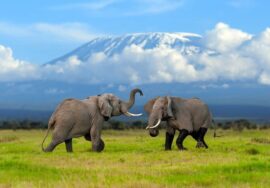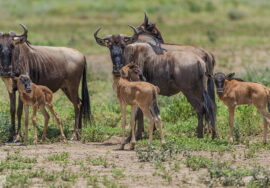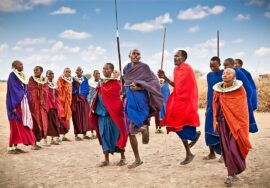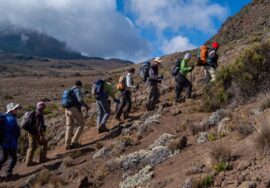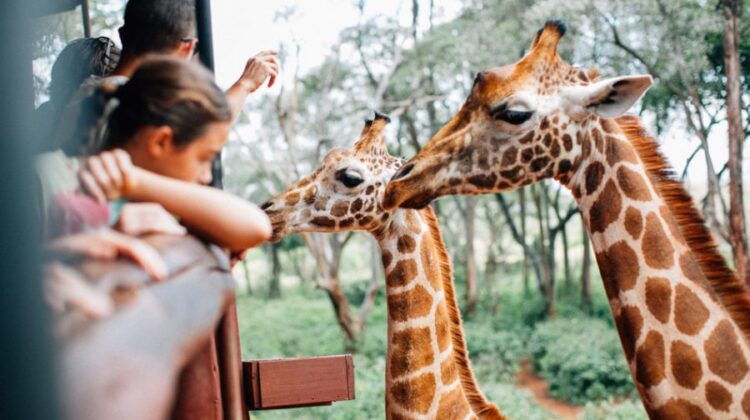
15 Best Things To Do In Tanzania
15 Best Things To Do In Tanzania, Some of the most famous national parks and natural sites in Africa are in Tanzania. For example, the amazing Mount Kilimanjaro is in this country. Find out what we think are the best things to do in Tanzania! Safaris and other activities that involve animals are the most popular things to do in Tanzania and the main reasons people travel there. The beautiful beaches of Zanzibar are also very popular with people who want to relax in the sun.
You can use this list of Tanzania’s best sites and things to do to narrow down your choices and find the best places to visit.
1. A National Park in Serengeti
In Serengeti National Park, there is a huge area with no trees that millions of animals live on or pass through on their way to find new grasslands. Some of the most famous animals in Africa can be seen here, but the wildebeest migration is what makes it famous. Some tens of thousands of zebras and gazelles, along with more than 1.5 million wildebeest, start their annual migration in May or early June.
This movement is the main draw for many tourists because it is one of nature’s most beautiful shows. Also, there are almost 500 different kinds of birds that live in the Serengeti. A lot of people visit the Serengeti every year; it’s Tanzania’s second-largest national park. In Serengeti National Park, the best time to see animals is from June to September.
2. Beaches in Zanzibar
The island of Zanzibar in Tanzania, which is also called Unguja, is a famous place to go on vacation because of its beautiful beaches. Pemba is another island in the Zanzibar group, which also has this one. It has some of the world’s most beautiful beaches. There are beautiful white beaches, clear, shallow water, and traditional boats all along the shore. From one side of the island to the other, the surf is different.
3. There is Kilimanjaro.
The most recognized picture of Tanzania is of Mount Kilimanjaro, which is Africa’s tallest mountain at 5,895 meters. Unlike other parks in northern Tanzania, Mount Kilimanjaro National Park is mostly visited to see the beautiful snow-capped mountain and, for many, to try to climb it. You can climb Mount Kilimanjaro at any time of the year, but the best time is from late June to October, when the weather is dry. Kilimanjaro, a World Heritage Site, was formed by volcanoes in the Rift Valley more than a million years ago.
It is thought that Shira, Kibo, and Mawenzi were all made by volcanoes about 750,000 years ago. The tallest hill is Uhuru hill on top of Kibo, which is one of the Seven Summits of the world. At its base, the mountain is a farming area.
At its highest point, it’s a rainforest, then an alpine meadow, and finally a lunar landscape. In the bush, you can see elephants, buffalo, monkeys, and leopards. In the alpine area, you can see a lot of different birds. The government cleared a plan to build a cable car on Mount Kilimanjaro in late 2020, but there is no work going on right now. After that, people would be 3,700 meters above sea level.
4. The conservation area of Ngorongoro
The Ngorongoro Conservation Area is one of the best places in Tanzania to see animals, and it is also home to the famous Ngorongoro Crater. It’s in the middle of the Serengeti and Lake Manyara. A lot of different animals are comfortable in this huge volcanic hole because it always has water, so they don’t have to move.
Big animals and birds are the main reasons people come to this place. The bottom of the crater is home to thousands of species, such as lions, elephants, rhinos, Thomson’s gazelles, and buffalo. However, wildebeests and zebras make up more than half of the animals that live there. Near Lake Magadi, where flamingos gather in the shallow water, is the best place to watch birds. Hippos like to stay underwater during the day and graze on the grass next to them in the evening.
It is the world’s biggest preserved ancient caldera and is thought to be about three million years old. The Ngorongoro volcano was one of the world’s largest points before it erupted and fell. Another interesting part of the protected area is the Olduvai Gorge. Ancient skulls and bone pieces found at this important archaeological site have taught us a lot about the first people who lived there. Ancient human remains and fossils have been found in Olduvai Gorge, which is on a number of fault lines. This is because the rock has been worn away over thousands of years.
An American professor was looking for butterflies in the Olduvai Gorge in 1911 when he came across some preserved bones. During a later trip, the Leakeys found bones that were thought to be about 2 million years old, along with parts of a head. Tools and hunting gear from one to five million years ago were also found, along with the famous footprints of a man, a woman, and a baby at Laetoli, which is close to Olduvai. These and other discoveries show that at least three types of hominids lived in this area more than two million years ago.
5. Mafia Island
People come to Mafia Island from all over the world to dive and swim and see the underwater world that the Mafia Island Marine Park protects. Mafia Island has the best weather from May to October, but the best times to dive are from October to March. Mafia Island Marine Park has a lot of different species, beautiful coral gardens, and a calm place to dive.
About 400 different kinds of fish and many bird species live in the area. Also, Mafia Island is where the green turtle, which is sadly on the brink of going extinct, used to lay its eggs. Many people like to go deep-sea fishing in Mafia, especially for big game fish like tuna, marlin, sailfish, and more.
6. National Park of Tarangire
Tarangire National Park, which opened in 1970, is a great spot to see animals. Animals gather near the river during the dry season, which lasts from July to September. This is the best time to go. During the dry season, a lot of animals that come from farther away, like wildebeest, zebra, buffalo, impala, gazelle, hartebeest, and eland, meet in the lagoons of Tarangire National Park.
Many other things make the park famous, like the many elephants that live there and the baobab trees that dot the green hills. With more than 300 different kinds of birds known to live in Tarangire, the park is a great place to watch birds. Many of these species are birds of prey, like eagles, falcons, herons, vultures, and storks.
7. Island of Pemba
Pemba Island is the most northern island in the Zanzibar group of islands. Near Pemba, there are a number of desert islands with the best sight in the Indian Ocean for scuba diving. There are sea fans, coral gardens, and bright crabs in the underwater paradise. Chake Chake, the main town on Pemba, is a popular place for scuba divers to start their trips. Pemba is less tense than Zanzibar because there are not as many people there.
People who ride mountain bikes especially want to climb the rough 1,000-meter hills with deep valleys. The close Misali Island Beach is a must-see. It has a beautiful white sand beach waiting for you. Pemba is known for its healing and magical juju practices and is a major producer of cloves around the world. A lot of people come from all over East Africa to learn from traditional and voodoo doctors or get better.
8. The park is called Lake Manyara.
The land in Lake Manyara National Park is made up of woods, meadows, and swamps. A lot of water covers two-thirds of the park. Lake Manyara is home to many birds, including thousands of flamingos at certain times of the year. The best things about Lake Manyara are the large number of elephants, the lions that can climb trees, and the hippos that you can see up close, which is not possible in other parks. This park is home to more baboons than any other place in the world. Bird watching, kayaking, mountain biking trips, and wildlife drives are some of the most popular things to do in Lake Manyara National Park.
9. The park named after Julius Neyere
The African continent’s biggest game area is Julius Neyere National Park. It has been around since 1922 and takes up 5% of Tanzania. People are not allowed to go to the southern area. It hasn’t been built on yet, is very wooded, and has a lot of hills. Travelers can only get to the area north of the Rufiji River. In this part of the Julius Neyere National Park, you can find large open fields, forests, rivers, hills, and plains.
The Rufiji River cuts through the Julius Neyere National Park. It drains the largest amount of land in East Africa. The river is an important part of the area, and you can see many kinds of animals that live in water there. There you can see buffalo, antelope, giraffes, warthogs, wildebeest, lions, leopards, and cheetahs, as well as elephants, hippos, and rhinos. More than 350 different kinds of birds have been named in Julius Neyere National Park.
10. Stone Town
Stone Town, which is the culture center of Zanzibar, hasn’t changed much in the last 200 years. The grand old Arabian houses that line the city’s winding lanes and streets give it its own unique beauty. Most of the homes in Stone Town were built during the 1800s, when Zanzibar was one of the most important Swahili trade ports in the Indian Ocean. A lot of the houses have beautifully made wooden doors with bras that can be seen by people who come to look at them. Stone Town is the oldest continuously inhabited Swahili city in the world. Many of its famous sites have been brought back to their former glory.
Several of the old buildings are now museums or places where tourists go. There are a few interesting old buildings with historical value spread out in the town. You can walk down Creek Road to get to the old Stone Town area, which is home to the Darajani Market, Beit el-Amani, City Hall, and the Anglican Cathedral.
Some of the most interesting places in Stone Town are the Forodhani Gardens, the Old Dispensary with its carved wooden staircases, Beit el-Sahel, also known as the People’s Palace, which was once the home of the sultans, the Hamamni Persian Baths, which were built in 1888, and the Old Fort, which is the town’s oldest building.
11. The Lake Victoria
Lake Victoria is the largest freshwater lake in Africa. It is surrounded by Kenya, Tanzania, and Uganda. There are millions of people living near this lake, which feeds the White Nile and makes money for them. Tanzanian Lake Victoria is one of the least visited parts of the country, but the towns of Bukoba, Musoma, and Mwanza have many things to see and do.
A number of the islands near Mwanza and Musoma have been turned into safe places for wildlife. There are boat rides and hikes you can take around Lake Victoria. You can also go bird watching and fishing. There is a park called Rubondo Island National Park on the southwest side of Lake Victoria. It has a number of other smaller islands.
12. The national park of Gombe Stream
Gombe National Park, which is also called Gombe Stream National Park, is mostly visited by tourists who want to see chimpanzees and get away from the crowds. Through her study, Jane Goodall made this place, one of Tanzania’s smallest national parks, famous. The British researcher came to the country for the first time in 1960 to study chimpanzees in the wild. Her work finally led to the start of the longest-running behavioral research project in the world.
Chimpanzees live in the forest, and people can go on guided walks into the forest to see them. People and many kinds of animals live in the park. Over 200 kinds of birds live in the tropical forest. These birds include crowned eagles, kingfishers, sunbirds, barbets, and palm-nut vultures. People also like to hike and swim there. There is a path that goes into the forest and ends at a waterfall in a valley.
13. The National Park of Katavi
The wild nature of Katavi National Park has not been changed in any way. One thing that makes Katavi unique is its huge flood plain, which is split up by the Katuma River and several yearly lakes. More than 400 kinds of birds and big groups of hippos can be seen in the lakes. One interesting thing to see in Katavi is the hippos at the end of the dry season, when up to 200 of them try to fit into a pool of water.
During the dry season, Katavi National Park comes to life. Herds of impala, reedbuck, lions, zebras, and giraffes meet at the last few ponds and streams to drink. Tens of thousands of elephants and buffalo will also gather in the park when the floodwaters go down.
14. National Park of Arusha
Arusha is one of Tanzania’s smaller national parks, but it has a lot of different environments, such as the forest on Mount Meru, the Ngurdoto Crater in the southeast, and the Momella Lakes, which are a group of seven crater lakes. Buffalo, zebra, and warthog groups can be seen roaming around the swampy bottom of the crater. In the forest around the crater, black and white Colobus monkeys can be seen.
Momella Lakes are home to many types of local and migrating waterbirds. People come here to see the animals and to climb Mount Meru, which is Tanzania’s second-highest mountain and one of the most beautiful volcanoes in Africa. From the peak’s thin slope, you can see the volcanic cone in the crater, which is several thousand feet below. The views are stunning. Even though there is a steep climb, the trail goes through parks, a forest, a lot of heather, and moorland.
15. The park of Ruaha
The biggest park in Tanzania, Ruaha National Park, opened in 2008. It has one of the biggest populations of elephants in Tanzania, as well as large groups of buffalo and gazelles. The Great Ruaha River is the main feature of Ruaha National Park.
Along its banks, you can see a lot of beautiful wildlife. Through a hydropower plant in Kidatu, the river also helps Tanzania’s power needs in a big way. The nature in Ruaha National Park is mostly still untouched because it is the least visited park in Tanzania. Birdwatchers can see more than 400 kinds of birds that don’t live in northern Tanzania. Photographers are drawn to the river, the beautiful gorges, and the tall trees.
Questions People Ask Often
When is the best time to go on a safari in Tanzania?
The best time to visit Tanzania is during the long dry season, which lasts from July to October. The best times to see the Great Migration, go on treks, safaris, or take a beach holiday in Zanzibar are during these months. In Tanzania, July is the busiest month of the year. As they move toward Kenya, elephants are gathering at Tarangire National Park.
In August, you have a better chance of seeing the Big Five because animals start looking for water, which helps guides plan their routes. There are also a lot of flamingos that come to Lake Natron to find food and safety. Wildebeest and zebras that come and go from Africa roam the Serengeti in September, the last month of the busy season.
The biggest thing that stops them is the Mara River, which comes from Kenya’s Northern Serengeti. It can be exciting to see groups of wildebeest desperately swimming through water full of crocodiles. Visitors who are interested in wildebeests should go to the Ndutu Plains near the end of January to see the calves being born.
How do I get to the best beaches in Tanzania?
The best beaches in Tanzania are on the island of Zanzibar. The water is blue and the sand is unbelievably white. One of the best places to kiteboard on the island is Paje Beach, which is one of the best beaches on the island. There are also some very good second-place beaches on Mafia Island and Pemba Island, especially Misali Island Beach and Utende Beach.
Which town in Tanzania is the best for tourists?
Stone Town in Zanzibar is one of the best places to visit in the world. People who come to the town can talk to the friendly locals, walk through the tight alleys, or go to the Old Fort, a beautiful historic building in the town that was built by the Omani Arabs to protect themselves from the Portuguese. Street food that will make your mouth water is available at the beautiful Forodhani Night Food Market. The beautiful Swahili building, the lively and busy markets, and the stunning view of the ocean make the town spectacular and one of a kind.
Should you go to Tanzania?
Tanzania really does have something for every kind of tourist. Some of the things that people come to see and do are amazing game areas full of animals, beautiful beaches, luxurious hotels, and delicious food and culture.
In Tanzania, what are the best things to do?
To get the most out of your trip to Tanzania, you should make a list of all the things you want to do. These must-see tourist spots should be on your list of places to see on your trip. All of the things on our list of the 15 best things to do in Tanzania will give you a great look at the country and make your trip unforgettable.


